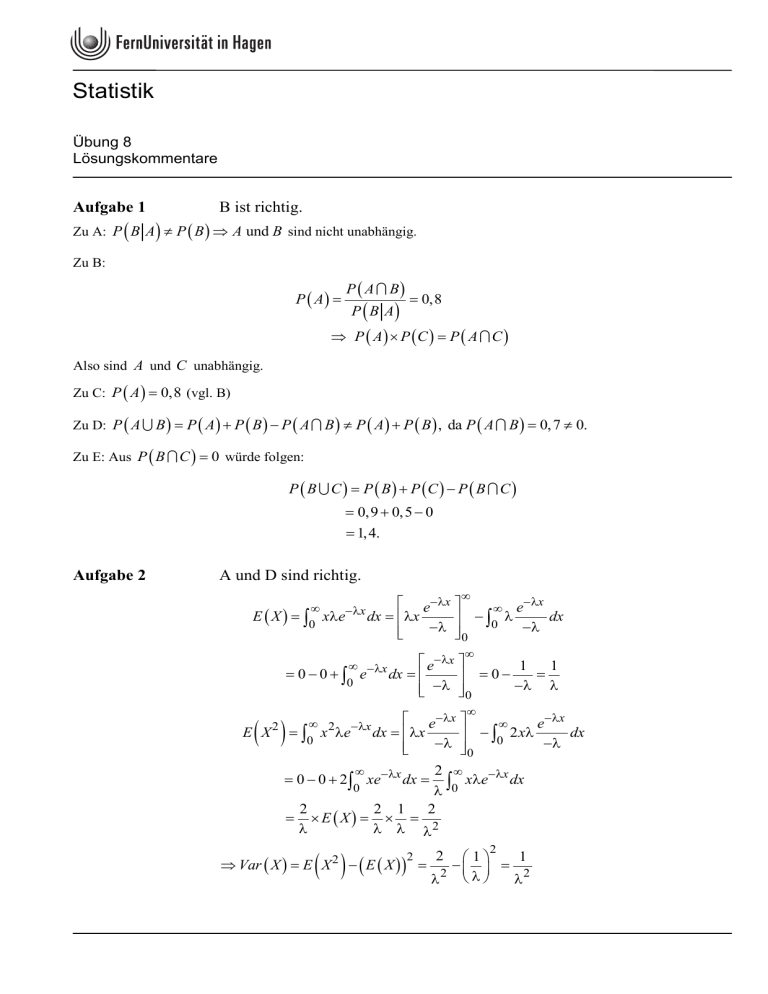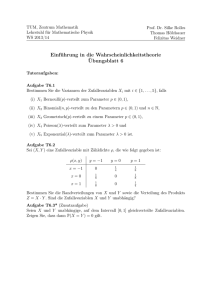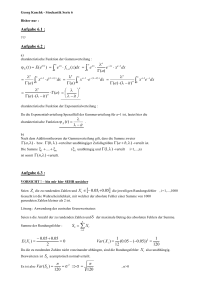( ) ( ) Statistik
Werbung

Statistik Übung 8 Lösungskommentare B ist richtig. Aufgabe 1 ( ) Zu A: P B A ≠ P ( B ) ⇒ A und B sind nicht unabhängig. Zu B: P ( A) = P ( A ∩ B) P ( B A) = 0,8 ⇒ P ( A) × P (C ) = P ( A ∩ C ) Also sind A und C unabhängig. Zu C: P ( A ) = 0,8 (vgl. B) Zu D: P ( A ∪ B ) = P ( A ) + P ( B ) − P ( A ∩ B ) ≠ P ( A ) + P ( B ) , da P ( A ∩ B ) = 0, 7 ≠ 0. Zu E: Aus P ( B ∩ C ) = 0 würde folgen: P ( B ∪ C ) = P ( B) + P (C ) − P ( B ∩ C ) = 0,9 + 0,5 − 0 = 1, 4. Aufgabe 2 A und D sind richtig. ∞ xλe−λx dx 0 E(X) = ∫ ∞ −λx e−λx ∞ e dx = λx − ∫0 λ −λ −λ 0 ∞ −λx e dx 0 = 0−0+∫ ( )=∫ E X ∞ 2 −λx x λe dx 0 2 ∞ e−λx 1 1 = = = 0− −λ λ −λ 0 ∞ e−λx e−λx ∞ = λx dx − ∫0 2 xλ −λ −λ 0 ∞ 0 2 ∞ xλe−λx dx ∫ 0 λ 2 = 0 − 0 + 2 ∫ xe−λx dx = = 2 2 1 × E(X) = × = λ λ λ λ2 ( ) − ( E ( X )) ⇒ Var ( X ) = E X 2 2 2 1 1 = − = 2 λ λ λ2 2 2 B, C und E sind richtig. Aufgabe 3 1 1 xy + x + 0 x2 x2 1 1 1 3 + + x = y + für 0 ≤ y ≤ 1. dx = y 4 2 4 2 4 2 0 1 xy + x + 0 y2 1 1 1 1 3 1 = dy x + xy + y = x + x + = x + für 0 ≤ x ≤ 1. 4 4 2 4 2 4 2 Zu A: fY ( y ) = ∫ Zu B: f X ( x ) = ∫ 1 0 Zu C: 3 3 1 1 1 1 1 E (Y ) = ∫ y × fY ( y ) dy = ∫ y y + dy = ∫ y2 + y dy 0 0 2 0 4 4 2 1 1 y3 3 y2 1 3 13 = × + × = + = 2 3 4 2 0 6 8 24 Zu D: ( f X x y = E (Y ) ) 13 f XY x, y = 24 = = 13 fY y = 24 13 1 x 1 + + 24 4 = 74 x + 12 1 13 3 49 49 × + 2 24 4 Zu E: 12 1 1 74 E X y = E (Y ) = ∫ xf X x y = E (Y ) dx = ∫ x x + dx 0 0 49 49 ( ) 1 74 2 x 0 49 =∫ Aufgabe 4 ( ) 1 74 x 3 12 x 2 12 74 12 92 + x dx = × + × = + = 49 147 98 147 49 3 49 2 0 C und D sind richtig. Zu A: P ( X1 < 3) = P ( X1 = 0 ) + P ( X1 = 1) + P ( X1 = 2 ) 10 10 10 = × 0,10 × 0, 910 + × 0,11 × 0,99 + × 0,12 × 0,98 0 1 2 = 0, 3487 + 0,3874 + 0,1937 = 0, 9298 Zu B: VarX1 = 10 × 0,1(1 − 0,1) = 0,9 Zu C: P ( X2 ≥ 10 ) = 1 − P ( X2 ≤ 9 ) = 1 − FX2 ( 9 ) = 1 − 0, 9919 = 0, 0081 Zu D: E ( X2 ) = 4 Zu E: Var ( X2 ) = 4 ⇒ σ X2 = 4 = 2 3 A und E sind richtig. Aufgabe 5 Zu A: P ( −σ ≤ X ≤ σ ) = P ( X ≤ σ ) − P ( X ≤ −σ ) = P ( X ≤ 1) − P ( X ≤ −1) = P ( X ≤ 1) − 1 − P ( X ≥ −1) = P ( X ≤ 1) − 1 − P ( X ≤ 1) = 2 P ( X ≤ 1) − 1 = 2 × 0,8413 − 1 = 0,6826. Oder: Im Glossar ist P ( −1 ≤ X ≤ 1) direkt mit 0,6827 angegeben. Zu B: Sei Z eine N ( 0, 1) -Verteilung. Dann ist aber nur (µ − σ ) − µ (µ + σ) − µ P (µ − σ ≤ X ≤ µ + σ) = P ≤Z≤ σ σ = P ( −1 ≤ Z ≤ 1) = 0, 6827 wegen A. B gilt also nur für µ = 0. ( ) Zu C: a − bX ist N a − bµ, b2σ2 -verteilt. Zu D: ( ) bX2 ist N ( bµ2 , b2 × σ22 ) -verteilt. aX1 ist N aµ1, a2 × σ12 -verteilt. ( ( ⇒ aX1 + bX2 + c ist N aµ1 + bµ2 + c, a2σ12 + b2σ22 Aufgabe 6 )) -verteilt. D ist richtig. Sind die Zufallsvariablen X1, X2 ,..., Xn poisson-verteilt mit den Parametern µ1, µ2 ,..., µ n und stochastisch unabhängig, so ist X = ∑ Xi poisson-verteilt mit dem Parameter µ = ∑ µi µ = 9 : P ( X > 8) = 1 − P ( X ≤ 8) = 1 − 0, 4557 = 0,5443 Aufgabe 41 [0,20; 0,24] Es sei A das Ergebnis, dass das Stück von Maschine A kommt, B, C entsprechend. F sei das Ereignis, dass das Stück fehlerhaft ist. Dann gilt: 400 100 500 P ( B) = = 0, 4 = 0,1 P ( C ) = = 0, 5. 1000 1000 1000 P ( F A ) = 0, 01 P ( F B ) = 0, 04 P ( F C ) = 0, 02 P ( A) = P (F F ) = = P ( B) × P ( F B) P ( A) × P ( F A) + P ( B ) × P ( F B ) + P (C ) × P ( F C ) 0, 4 × 0, 01 4 = 0.22222 = 0, 4 × 0, 01 + 0,1× 0, 04 + 0, 5 × 0, 02 18 4 Aufgabe 42 [0,30; 0,31] Sei X ∼ N ( 255;10 ) - und Z ∼ N ( 0; 1) , dann gilt: X − 255 250 − 255 < P ( X < 250 ) = P = P ( Z < −0,5) 10 10 = P ( Z > 0,5) = 1 − P ( Z ≤ 0,5) = 1 − 0,6915 = 0,3085. Aufgabe 43 [0,545; 0,550] X sei eine Zufallsvariable, die die Anzahl der defekten Transistoren widergibt. Dann kann X als B (1700; 0, 01) verteilt angesehen werden. Gesucht wird die folgende Wahrscheinlichkeit: P (1700 × 0, 01 ≤ X ≤ 1700 × 0, 02 ) . Wegen n × P × (1 − P ) = 1700 × 0, 01× 0,99 = 16,83 > 9 , ist X näherungsweise N (17; 4,102 ) -verteilt. Unter Berücksichtigung der Stetigkeitskorrektur kann dann die gesuchte Wahrscheinlichkeit wie folgt approximiert werden: P (17 − 0, 5 ≤ X ≤ 34,5 ) = P ( −0, 5 ≤ X − 17 ≤ 17,5) −0,5 X − 17 17, 5 = P ≤ ≤ 4,102 4,102 4,102 ≅ P ( −0,12 ≤ Z ≤ 4,27 ) = FZ ( 4,27 ) − FZ ( −0,12 ) = FZ ( 4,27 ) − 1 + FZ ( 0,12 ) = 1 − 1 + 0,5478 = 0, 5478.

